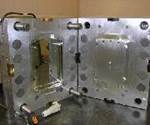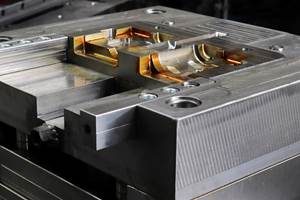Bulked-Up Coatings Increase Mold Productivity
Which choice is the best coating - one that provides long production life and minimal maintenance needs.
Every mold shop is searching for ways to improve mold production, make customers happy and increase their loyalty. It all begins with building a precision mold and in most cases ends with finding the best coating that provides long production life and minimal maintenance needs.
Traditionally, hard chrome and electroless nickel have filled the bill, but with today's advanced technology, moldmakers have access to bulked-up coatings or traditional coatings with something extra. It's the extra that can help keep customers coming back. Before addressing these bulked-up coatings, let's review the important aspects of hard chrome and electroless nickel in their purest forms.
Hard Chrome
At 72 Rc, hard chrome is used for solid protection against abrasion and is commonly applied at between 0.0002-inch and 0.0004-inch thickness. It is especially beneficial when molding glass-filled materials, but is not recommended for use with PVC because the chloride contained in PVC will cause chrome to slowly dissolve. Hard chrome has a coefficient of friction at 0.20 or less - the lower the number, the less resistance (see Chart 1) and is plated at a low 130xF, so it won't cause a drawing down of hardness or tool distortion. Hard chrome is used effectively for shimming or correcting for size on inserts, cavities or cores with heavier accumulations. It also offers minimal corrosion protection.
Diamond Chrome
Technology now makes it possible to put one of the most precious natural commodities into a coating material like chrome and make it even more abrasion-resistant - hard chrome with diamonds. Diamond chrome boasts a hardness of more than 85 Rc - far superior for abrasion resistance than hard chrome alone and almost unheard as recently as ten years ago.
What makes diamonds and chrome so effective together is the chemistry the two have with one another. The diamond's carbon conductivity causes increased ionization of the chrome, allowing the chrome ions to cling to the diamond particles more easily - particles that are nanometer-sized and spherically shaped so that they will not abrade the material that is being molded. An ultra-high dispersion of the diamond particles codeposited in the chrome composite creates a tougher, more abrasion-resistant mold surface.
Because diamond chrome has a low plating temperature of about 130xF, there is no risk of annealing. Although diamond chrome is comparable to hard chrome alone for corrosion protection, it has 0.05 less coefficient of friction than chrome, giving it better release properties, and its plating thickness ranges between 0.00004 and 0.002. It is advantageous to use diamond-chrome on moving components - including slides, rotating cores, locks and other high-wear areas.
Electroless Nickel
When you are more concerned with corrosion protection, electroless nickel is usually the chosen coating. It offers moderate abrasion resistance with a 50 Rc hardness rating, but corrosion resistance is what it does best. Electroless nickel plates uniformly and is great for very localized applications - such as when you need to correct size on threaded cores or slides. Its application temperature is a bit higher than chrome or diamond chrome at 185xF, and its coefficient of friction also is higher at 0.45 or less.
Depending on what kind of performance you require from the mold, you can plate it first with electroless nickel as a base for corrosion protection and top that with a coating of hard chrome. This two-step process optimizes both corrosion and abrasion resistance. Electroless nickel gives excellent chemical resistance, so it always is highly recommended for use with PVC.
Nickel Cobalt
Looking at how electroless nickel has evolved, it's clear that it is a more versatile material than hard chrome because it has been technologically bulked up in two different ways, and both work quite nicely when you know what you want from the tool that is plated - enter cobalt and PTFE.
When you need good abrasion and corrosion resistance as well as uniform coverage over complex details, a nickel-cobalt alloy coating will do. At 62 Rc, nickel cobalt provides surface protection closer to that of hard chrome because the addition of cobalt provides abrasion resistance that nickel does not normally have. As an alloy, both materials are transferred via ionic reduction to the base material.
The two-step process by which you can achieve excellent corrosion and abrasion protection uses electroless nickel as a base coat followed by a coating of hard chrome. It is important to clarify that nickel cobalt can be more economical than hard chrome because it is a one-step process and offers even distribution over very complex details whereas hard chrome does not.
The money savings is even more apparent when you point out the time involved - often up to two days - in building an anode for the application of hard chrome on a complex mold. The last thing anyone wants to do is drive up costs needlessly. By using nickel cobalt, you stand to save as much as two-thirds of the cost of hard chrome.
Weigh your options and consider your customer's needs. Even if you need more frequent maintenance for the mold, savings of two-thirds over hard chrome could be well worth the switch to a coating with nearly as much abrasion protection and better coverage. Nickel cobalt plates at 185xF and has a coefficient of friction of 0.24 or less.
If corrosion protection and/or release are your main concerns, a nickel-PTFE composite coating is perfect for the job. Whereas nickel cobalt is harder, nickel PTFE is more lubricious in nature. Plus, with a 45 Rc rating, it still may increase the surface hardness of your mold components. Corrosion protection is excellent and lubricity is superior because it contains PTFE of approximately 25 percent by volume. Additionally, because of the codeposit nature of this coating, the PTFE particles are evenly distributed throughout the nickel. So, unlike sprayed-on PTFE, it will maintain its coefficient of friction for the duration of the coating.
Applied temperature remains the same as electroless nickel and nickel cobalt at 185xF, but note that the coefficient of friction is a low 0.10 or less - reinforcing the release characteristics of the material. Uses for nickel PTFE are numerous and include thin-wall molding, such as that for cell phones or pager housings. Also, it is great for use on deep ribs, no-draft cores, and textured surfaces and difficult-to-eject polymers.
Hard chrome and electroless nickel still offer many benefits and remain widely used, but advances in technology and new manufacturing practices, not to mention customer demands, have promoted making what is old, new again - bulked-up coatings that increase mold productivity.
Related Content
Machine Hammer Peening Automates Mold Polishing
A polishing automation solution eliminates hand work, accelerates milling operations and controls surface geometries.
Read MoreHow to Use Diffusion Bonding to Optimize a Mold’s Thermal Performance
Joining dissimilar metals has tremendous potential for conformal cooling, but to successfully use diffusion bonding, a mold builder must understand the complexities of the interface and its effect on the chemical and thermo-mechanical properties of the bond.
Read MorePredictive Manufacturing Moves Mold Builder into Advanced Medical Component Manufacturing
From a hot rod hobby, medical molds and shop performance to technology extremes, key relationships and a growth strategy, it’s obvious details matter at Eden Tool.
Read MorePrecision Welding Services Offer Rapid Turnaround Mold Repair and Reduced Molder Downtime
X-Cell Tool & Mold relies on outsourced, high-quality welding repairs from Lewis-Bawol Welding to ensure its customers' molds are back in production quickly and affordably.
Read MoreRead Next
Optimizing Aluminum Tools
Plating aluminum molds for longer production life.
Read MoreHow to Use Continuing Education to Remain Competitive in Moldmaking
Continued training helps moldmakers make tooling decisions and properly use the latest cutting tool to efficiently machine high-quality molds.
Read MoreHow to Use Strategic Planning Tools, Data to Manage the Human Side of Business
Q&A with Marion Wells, MMT EAB member and founder of Human Asset Management.
Read More











.png;maxWidth=300;quality=90)









.jpg;maxWidth=300;quality=90)







